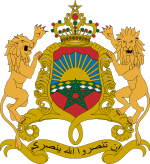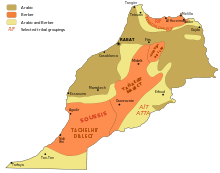- Demographics of Morocco
-
This article is about the demographic features of the population of Morocco, including population density, ethnicity, education level, health of the populace, economic status, religious affiliations and other aspects of the population.
Most Moroccans are Sunni Muslims, mainly of Arab-Berber, Arabized Berber or Berber stock. Morocco was inhabited by Berbers since at least 5000 years ago. The Arabs conquered the territory that would become Morocco in the 7th and 11th centuries, at the time under the rule of various late Byzantine Roman princips and indigenous Berber and Romano-Berber principalities, such as the one of Julian, count of Ceuta, laying the foundation for the emergence of the Morish culture. A small minority of the population is identified as Haratin and Gnaoua, dark-skinned sedentary agriculturalists of the southern oases that speak either Berber or Arabic. Morocco's Jewish minority has decreased significantly and today numbers about 5,000. Most of the 100,000 foreign residents are French or Spanish.
Recent studies make clear no significant genetic differences exist between Arabic and non-Arabic speaking populations, highlighting that in common with most of the Arab World, Arabization was mainly via acculturation of indigenous populations over time and intermarriage between Arabs and Berbers.[1] According to the European Journal of Human Genetics, Moroccans from North-Western Africa are genetically closer to Iberians and other South Europeans than to Middle Easterners and Sub-Saharan Africans.[2]
Contents
Languages
See also: Languages of MoroccoClassical Arabic is Morocco's official language (it is the "classical" Arabic of the Qur'an, literature and news media). The country has a distinctive dialect of Arabic known as Moroccan Arabic.
More than 30 million Moroccans of Berber origin speak Berber in three varieties (Riff, Shilha, and Central Atlas Tamazight), either as a first language or bilingually with Moroccan Arabic. French, which remains Morocco's unofficial third language, is taught throughout school and still serves as Morocco's primary language of commerce and economics; it is also widely used in education and government. Morocco is a member of La Francophonie. Berber activists have struggled for half a century for the recognition of their language as an official minority language of Morocco in the Moroccan constitution.
About 20,000 Moroccans in the northern part of the country speak Spanish. English, while still far behind French and Spanish in terms of the number of speakers, is rapidly becoming the second foreign language of choice among educated youth, after French. It has been taught to Moroccan students after the fourth year of school since the education reforms of 2002.
Status of women
The literacy rate is 51 percent for males and 42.5 percent for females. 26 percent of the non-agricultural labor is female. The ratio of girls to boys in primary and secondary schools is 87.9. In the past 20 years, the government has taken initiatives to improve the status of women in society. For instance, the Moudawana 2003 code of law has greatly improved the family status code. It has given women the right to make decisions on marriage, divorce, and custody of children in the case of remarriage/divorce.[3] Nevertheless, gender bias is still commonplace in education, employment and the law.
Main populated areas
Most people live west of the Atlas Mountains, a range that insulates the country from the Sahara Desert. Casablanca is the center of commerce and industry and the leading port; Rabat is the seat of government; Tangier is the gateway to Morocco from Spain and also a major port; Fez is the cultural and religious center; and Marrakech is a major tourist center.
Education
Education in Morocco is free and compulsory through primary school (age 15). Nevertheless, many children—particularly girls in rural areas—still do not attend school. The country's illiteracy rate is usually around 50 percent for most of the country, but reaches as high as 90 percent among girls in rural regions. In July 2006, Prime minister Driss Jettou announced that illiteracy rate has declined by 39 percent, while two million people had attended literacy courses during the past four years.[4]
Morocco has about 230,000 students enrolled in 14 public universities. The oldest and among the most prestigious is Mohammed V in Rabat, with faculties of law, sciences, liberal arts, and medicine. University of Karueein, in Fez, has been a center for Islamic studies for more than 1,000 years. Al Akhawayn University in Ifrane, founded in 1993 by King Hassan II and King Fahd of Saudi Arabia, is an English-medium, American-style university comprising about 1,700 students.
Statistics
The following demographic statistics for 2010 are from the CIA World Factbook, unless otherwise indicated.
Age structure
0-14 years: 28.7% (male 4,548,808/female 4,418,768)
15-64 years: 65.4% (male 10,009,928/female 10,437,103)
65 years and over: 6% (male 851,190/female 1,019,377) (2010 est.)[5]Population growth rate
1.099% (2010 est.)[5]
Birth rate
19.72 births/1,000 population (2010 est.)[5]
Death rate
4.74 deaths/1,000 population (July 2010 est.)[5]
Net migration rate
-3.99 migrant(s)/1,000 population (2010 est.)[5]
Sex ratio
at birth:1.05 male(s)/female
under 15 years:1.03 male(s)/female
15–64 years:0.96 male(s)/female
65 years and over:0.83 male(s)/female
total population:0.97 male(s)/female (2010 est.) [5]Infant mortality rate
29.75 deaths/1,000 live births (2010 est.) [5]
Life expectancy at birth
total population: 75.47 years
male:72.42 years
female:78.68 years (2010 est.) [5]Total fertility rate
2.23 children born/woman (2010 est.)[5]
Nationality
noun: Moroccan(s)
adjective: Moroccan
Ethnic groups
Arab-Berber 99.1%, other 0.7%, Jewish 0.2% [5]
- Category:Ethnic groups in Morocco
Religions
Muslim 98.7%, Christian 1.1%, Jewish 0.2%.[5]
- Category:Religion in Morocco
- Moroccan Jews
Literacy
Definition: age 10 and over can read and write
Total population: 61.55% (2007)[6]
External links
- (French) Results of the 2004 census
References
- ^ Genetic structure of north-west Africa revealed by STR analysis
- ^ Bosch, Elena; Francesc Calafell, Anna Perez-Lezaun, Jordi Clarimon, David Comas, Eva Mateu, Rosa Martınez-Arias, Bernal Morera, Zahra Brakez, Omar Akhayat,Abdelaziz Sefiani, Ghania Hariti, Anne Cambon-Thomsen and Jaume Bertranpetit (2000). "Genetic structure of north-west Africa revealed by STR analysis" (online). European Journal of Human Genetics 8 (5): 360–366. doi:10.1038/sj.ejhg.5200464. PMID 10854096. http://www.nature.com/ejhg/journal/v8/n5/pdf/5200464a.pdf.
- ^ Morocco Country Profile | Morocco Economy | Economy of Morocco | Thomas White Funds
- ^ [1][dead link]
- ^ a b c d e f g h i j k The World Factbook - Morocco
- ^ L'analphabétisme a reculé au Maroc
Demographics of Africa Sovereign
states- Algeria
- Angola
- Benin
- Botswana
- Burkina Faso
- Burundi
- Cameroon
- Cape Verde
- Central African Republic
- Chad
- Comoros
- Democratic Republic of the Congo
- Republic of the Congo
- Côte d'Ivoire (Ivory Coast)
- Djibouti
- Egypt
- Equatorial Guinea
- Eritrea
- Ethiopia
- Gabon
- The Gambia
- Ghana
- Guinea
- Guinea-Bissau
- Kenya
- Lesotho
- Liberia
- Libya
- Madagascar
- Malawi
- Mali
- Mauritania
- Mauritius
- Morocco
- Mozambique
- Namibia
- Niger
- Nigeria
- Rwanda
- São Tomé and Príncipe
- Senegal
- Seychelles
- Sierra Leone
- Somalia
- South Africa
- South Sudan
- Sudan
- Swaziland
- Tanzania
- Togo
- Tunisia
- Uganda
- Zambia
- Zimbabwe
States with limited
recognition- Sahrawi Arab Democratic Republic
- Somaliland
Dependencies and
other territories- Canary Islands / Ceuta / Melilla / Plazas de soberanía (Spain)
- Madeira (Portugal)
- Mayotte / Réunion (France)
- Saint Helena / Ascension Island / Tristan da Cunha (United Kingdom)
- Western Sahara
 Morocco topics
Morocco topicsHistory AncientEarly IslamicIdrissid dynasty · Barghawata Confederacy · Kingdom of Nekor · Umayyad Caliphate · Caliphate of CordobaMoroccan dynastiesIdrisids · Barghawata Confederacy · Almoravids · Almohads · Marinids · Wattasids · Saadis · AlaouitesEuropean influence
(1912-1956)Modern

Politics
EconomyGeography Culture Military Demographics Moroccans · Moroccan diaspora · Cities · Languages · Moroccan Arabic · Berber languages · Western SaharaCategories:- Moroccan society
- Demographics by country
Wikimedia Foundation. 2010.



